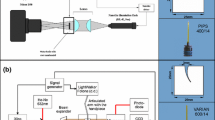Abstract
Cavitation and agitation generated by lasers in fluid-filled root canals create fluid movement and shear stresses along the root canals walls, enhancing removal of the smear layer and biofilm. When used with sodium hypochlorite and EDTA, laser activation of aqueous fluids can increase the efficiency of debridement and disinfection of root canals. However, the use of forward-firing laser fibers with such solutions poses a risk of driving fluid past the root apex, which could cause postoperative complications. The purpose of this study was to evaluate the mechanism of fluid agitation caused by a novel honeycomb tip. Glass capillary tubes filled with distilled water were used to replicate single-tooth root canals. A 980 nm pulsed diode laser was used with 200 μm diameter plain tips, tube-etched conical tips, and honeycomb tips. To record fluid movements, the tubes were backlit and imaged using a digital camera attached to a microscope. The honeycomb tips generated agitation with fluid movement directed onto the walls, while both the conventional plain fibers and the conical tips created fluid movement largely in a forward direction. The use of honeycomb tips alters the pattern of fluid agitation, and this laterally directed effect might lower the risk of fluid extrusion beyond the apex.





Similar content being viewed by others
References
McComb D, Smith DC (1975) A preliminary scanning electron microscopic study of root canals after endodontic procedures. J Endod 1(7):238–242
Froes JA, Horta HG, da Silveira AB (2000) Smear layer influence on the apical seal of four different obturation techniques. J Endod 26(6):351–354
Fogel HM, Pashley DH (1990) Dentin permeability: effects of endodontic procedures on root slabs. J Endod 16(9):442–445
Monika CM, Froner IC (2006) A scanning electron microscopic evaluation of different root canal irrigation regimens. Braz Oral Res 20(3):235–240
O'Connell MS, Morgan LA, Beeler WJ, Baumgartner JC (2000) A comparative study of smear layer removal using different salts of EDTA. J Endod 26(12):739–743
Guerisoli DM, Marchesan MA, Walmsley AD, Lumley PJ, Pecora JD (2002) Evaluation of smear layer removal by EDTAC and sodium hypochlorite with ultrasonic agitation. Int Endod J 35(5):418–421
Stamatova IV, Vladimirov SB (2004) The smear layer in the root canal and its removal. Folia Med (Plovdiv) 46(4):47–51
Karunakaran JV, Kumar SS, Kumar M, Chandrasekhar S, Namitha D (2012) The effects of various irrigating solutions on intra-radicular dentinal surface: an SEM analysis. J Pharm Bioallied 4:S125–S130
Lotfi M, Moghaddam N, Vosoughhosseini S, Zand V, Saghiri MA (2012) Effect of duration of irrigation with sodium hypochlorite in clinical protocol of mtad on removal of smear layer and creating dentinal erosion. J Dent Res Dent Clin Dent Prospects 6(3):79–84
George R, Meyers IA, Walsh LJ (2008) Laser activation of endodontic irrigants using improved conical laser fiber tips for removing smear in the apical third of the root canal. J Endod 34(12):1524–1527
George R, Rutley EB, Walsh LJ (2008) Evaluation of smear layer: a comparison of automated image analysis versus expert observers. J Endod 34(8):999–1002
Hmud R, Kahler WA, George R, Walsh LJ (2010) Cavitational effects in aqueous endodontic irrigants generated by near-infrared lasers. J Endod 36(2):275–278
George R, Walsh LJ (2008) Apical extrusion of root canal irrigants when using Er:YAG and Er, Cr:YSGG lasers with optical fibers: an in vitro dye study. J Endod 34(6):706–708
Shoji S, Hariu H, Horiuchi H (2000) Canal enlargement by Er:YAG laser using a cone-shaped irradiation tip. J Endod 26(8):454–458
George R, Walsh LJ (2011) Performance assessment of novel side firing safe tips for endodontic applications. J Biomed Opt 16(4):048004
Meire MA, Prijck KD, Coenye T, Nelis HJ, Moor RJGD (2009) Effectiveness of different laser systems to kill Enterococcus faecalis in aqueous suspension and in an infected tooth model. Int Endod J 42(4):351–359
James PC, Richard JT, John H S Shaped fiber tips for medical and industrial applications. In: Gannot I (ed) Optical fibers and sensors for medical applications IV, June 2004. SPIE Proceedings pp 70–80
Gutknecht N, Franzen R, Schippers M, Lampert F (2004) Bactericidal effect of a 980-nm diode laser in the root canal wall dentin of bovine teeth. J Clin Laser Med Surg 22(1):9–13
Walsh LJ, George R (2011) Surface structure modification. US Pat Appl 20110217665
Walsh L J, George R (2010) Surface structure modification.World Intellectual Property Organization International Bureau, WO 2010/051579 Al.
Walsh L J, George R (2011) Surface structure modification. European Patent Appl. EP2379341A1.
Madarati AA, Qualtrough AJ, Watts DC (2009) A microcomputed tomography scanning study of root canal space: changes after the ultrasonic removal of fractured files. J Endod 35(1):125–128
Lagemann M, George R, Chjai L, Walsh LJ (2013). Activation of EDTA by 940 nm diode laser for enhanced removal of smear layer. Aust Endod J, in press.
Ho QV, George R, Sainsbury AL, Kahler WA, Walsh LJ (2010) Laser fluorescence assessment of the root canal using plain and conical optical fibers. J Endod 36(1):119–122
Hmud R, Kahler WA, Walsh LJ (2010) Temperature changes accompanying near infrared diode laser endodontic treatment of wet canals. J Endod 36(5):908–911
Acknowledgments
Two of the authors (RG and LJW) are named co-inventors of the honeycomb surface modification to optical fibers. We thank Sirona for providing on loan the laser system used in the study.
Author information
Authors and Affiliations
Corresponding author
Rights and permissions
About this article
Cite this article
George, R., Chan, K. & Walsh, L.J. Laser-induced agitation and cavitation from proprietary honeycomb tips for endodontic applications. Lasers Med Sci 30, 1203–1208 (2015). https://doi.org/10.1007/s10103-014-1539-y
Received:
Accepted:
Published:
Issue Date:
DOI: https://doi.org/10.1007/s10103-014-1539-y




